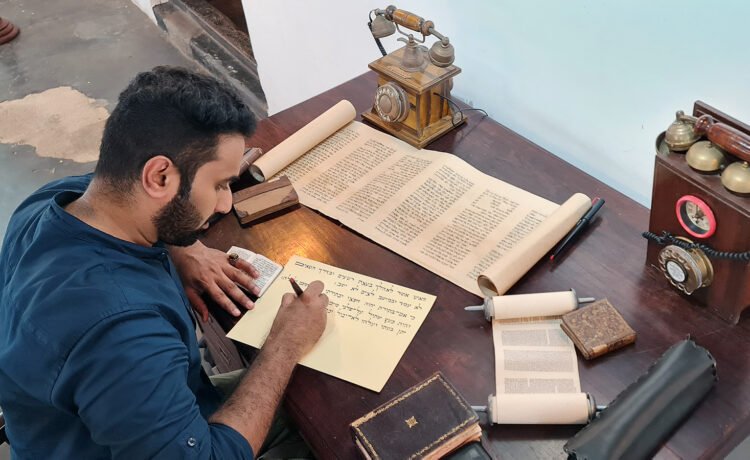Forgotten in a coconut field, an 800-year-old tombstone expands India’s Jewish history

(RNS) — When coconut farmers in India’s Tamil Nadu state stumbled across a stone covered in strange inscriptions, it’s unlikely they expected it to be a groundbreaking find in Indian Jewish history.
However, the stone — a tombstone with Hebrew writing — has been identified as one of the oldest Jewish artifacts in India and has opened a window into a previously unknown community.
“This discovery might be leading to a new chapter,” Thoufeek Zakriya, a Hebrew calligrapher and scholar of Indian Jewish history who translated the stone, told RNS.
When it comes to Jewish history in India, there are several communities usually discussed.
The oldest are the Cochin Jews of Kerala on southwest India’s Malabar coast. To the north is the Bene Israel community, which was centered around Mumbai and other cities of the subcontinent’s northwest, as far as Karachi in Pakistan. In the northeastern Manipur state are the Bene Menashe. Over the centuries, merchant communities of Baghdadi and Sephardic Jews would settle in the subcontinent’s major ports and trading centers. The Sephardic communities became collectively known as Paradesi — meaning foreign — Jews. The overwhelming majority of India’s Jews have migrated to Israel in the decades since the establishment of the Jewish state. Today, more than 70,000 Indian Jews live in Israel, while fewer than 5,000 remain in India.

The state of Tamil Nadu, red, in southern India. (Image courtesy Wikimedia/Creative Commons)
Historically, in Tamil Nadu, there was a Paradesi Jewish community centered around Chennai — then known as Madras.
The tombstone, however, was found more than 200 miles to the south in Ramanathapuram, a city in southeastern India on a peninsula that juts out toward Sri Lanka. Previously, there had been no communal memory of a Jewish community in that part of India and scant archaeological hints.
The death date on the stone, which places it in the 13th century, shows that it predates the Madras community by several centuries.
Communal lore tells that the Cochin Jews of Kerala arrived on the subcontinent in the 5th century BCE, following the destruction of Solomon’s temple and the Babylonian Exile. Christians in the same region trace their origin to Jesus’ disciple St. Thomas, claiming he traveled to India to spread the gospel in the 1st century CE.
However, the oldest Jewish tombstone in the country, the Sara Bat Israel Tombstone, is dated to 1269 CE. The stone discovered in Ramanathapuram is nearly half a century older, dated to between 1224 and 1226 CE.
Zakriya explained that the stone is now the third and most conclusive piece of evidence of a Jewish presence in the area. The first was another tombstone discovered in the 1940s, but the date on it was never recorded, and the artifact itself has been lost in the decades since India’s independence. Only research notes remain. It is possible it was from the same period.

The newly discovered tombstone is now thought to be the oldest Jewish artifact in India. (Photo courtesy Thoufeek Zakriya)
Despite containing only about a dozen words, the stone’s inscription still gives insight into the character of the community, namely its ties with Yemenite Jewry.
The date on the stone (2335) is not written in the Hebrew calendar (which would have been 5784) used by most Jewish communities today but rather in a system known as the Seleucid Era, which, instead of beginning with Genesis’ account of the creation of the world, began with the conquest of Babylon by Alexander the Great’s general, Seleucus I Nicator.
The Seleucid Era system was once commonplace across the Near East but is today used only by the Yemenite Jewish community as a legal calendar, called “Minyan Shtarot,” meaning the Era of Contracts.
Zakriya noted that other aspects of the Hebrew lettering inscribed on the stone are similar to examples found in Yemen and Yemenite communities. He believes the stone could indicate a colony of Yemenite Jews had once lived near Ramanathapuram, or at least that the community had a close connection with the Arab merchants, including Yemenite Jews, that were commonplace across India’s Malabar coast where Cochin is and Ma’bar coast where Ramanathapuram sits.
The stone could have been entirely lost were it not for a friend of Zakriya’s who recognized that the characters may be Hebrew and sent news about the finding to Zakriya who today lives in the United Arab Emirates.

Thoufeek Zakriya. (Photo courtesy Thoufeek Zakriya)
Zakriya grew up in southern India and speaks both Hebrew and the local Tamil language. Though a Muslim, an encounter with Indian Jews in Cochin’s historic Jew Town as a teenager set off a lifelong interest in Hebrew and in India’s Jewish history.
The stone itself is not 100 percent conclusive evidence of a community in Ramanathapuram, but Zakriye hopes it will spark further investigation of the area.
“If it was just one stone, maybe some people might say it’s just been relocated, but now it is two stones, the second Hebrew inscription and the third Jewish inscription in the area” Zakriya said.
“For anything and everything, there will be a baby step, a start, like the tip of the iceberg,” he added.
You Might Also Like
New book calls for authentic engagement and equity in organizations
The Nine Asks by Kimberly Danielle Organizations have a responsibility to ensure that people who come there to work, worship,...
‘Holy Hurt’ is Hillary McBride’s field guide to the shattering impact of spiritual trauma
(RNS) — Trauma is a lot like having a shard of glass in your hand, explains clinical psychologist Hillary McBride....
So You Married a Priest? + Beth Allison Barr
It’s ministry by marriage. Did you know there are piles of guidebooks meant to help women excel at...
Abyssinian Baptist Church welcomes dismissal of pastor candidate’s discrimination suit
(RNS) — A federal judge has dismissed a gender discrimination lawsuit brought against Abyssinian Baptist Church by a onetime candidate...









